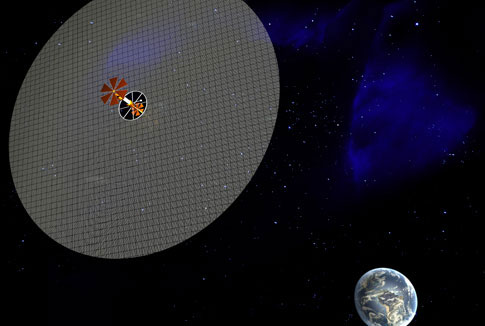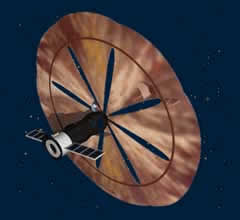|
Space Mirror
for City Illumination
|
 |
| Many years ago the
Russians experimented with space mirrors. The idea was to place a very large
mirror into earth orbit and have it redirect sunlight down onto the earth’s surface
below. The mirror would be positioned so the sunlight would illuminate a whole
city wide area during nighttime. Just how practical is this concept? How
bright would the light be? If it worked, then a city could use the mirror
instead of street lights, which could be a real energy saver. |
 |
One of the
first Russian attempts was a 20 meter (65 foot) diameter mirror, which was
designed to project a spot 5KM in diameter. But, that device failed. A
second attempt used a mirror 25 meters (82 feet) in diameter.
It partly worked and
illuminated a 7KM diameter spot on earth to a brightness 5 to 10 times that of
a full moon. I think to be practical; a lot more light will need to be
projected onto a larger surface area. |
| Space Mirror |
|
|
 |
 |
|
Russian Space Mirror |
Russian Space Mirror |
|
| After
some digging on the Internet, I learned that typical moon light intensity is 0.27
lux. One lux is a lumen per square meter. Typical clear sunlight is
130,000 lux. This sunlight intensity would be higher in space but once it made
its way through the earth’s atmosphere, it would be back to the same surface level. |
| What
should a target light level be for nighttime illumination in a city? I think
something around 50 lux might be reasonable. I also think that a target area
should be about a 10 mile (16KM) diameter circle. That should cover a medium size
city with a surface area of 78 square miles. If you divide 130,000 lux by 50
you get 2600. So, the area of the mirror would need to be 78 square miles
divided by 2600 or 0.03 square miles. That would put the mirror diameter at
about 1000 feet. That is big but I think it might be possible. It is not
known how this mirror would be kept in the right position to track the sun, so the
light spot would remain stationary. Aluminum coated Mylar plastic is fairly
light weight but we don’t have experience is an orbiting object with such a large
surface area. I would expect some problems with small forces such as solar wind on
such a large surface area. |
| Would
the general public in a city approve of this kind of wide area lighting? I’m
not sure. Some may object to a second sun up in the sky at night. If the
light is enough, it could mean many street lights would not have to be turned on.
But, the mirror would not help much during heavy overcast sky conditions, so street
lights may still be needed. I think this concept should be tried again with a
larger mirror, using perhaps a 100 meter diameter mirror. What do you think? |
| |
|
Notes:
The
intensity of moonlight varies greatly depending on the lunar cycle but even the full
moon typically provides only about 0.2 lux illumination, so the full moon is about
500,000 times fainter than the sun.
Illuminance is a
measure of how much luminous flux is spread over a given area. One can think of
luminous flux as a measure of the total "amount" of visible light present, and the
illuminance is a measure of the intensity of illumination on a surface. A given
amount of light will illuminate a surface more dimly if it is spread over a larger
area, so illuminance is inversely proportional to area.
In standard units,
luminous flux is measured in lumen. One lux is equal to one lumen per square
meter.
|
|
Illuminance |
Example |
|
10−4
lux |
Total starlight, overcast sky |
|
0.002 lux |
Moonless clear night sky with airglow |
|
0.01 lux |
Quarter moon |
|
0.27 lux |
Full moon on a clear night |
|
1
lux |
Full moon overhead at tropical latitudes |
|
3.4
lux |
Dark limit of civil twilight under a clear sky |
|
0
lux |
Family living room |
|
80
lux |
Hallway/toilet |
|
100
lux |
Very dark overcast day |
|
320–500 lux |
Office lighting |
|
400
lux |
Sunrise or sunset on a clear day. |
|
1,000 lux |
Overcast day; typical TV studio lighting |
|
10,000–25,000 lux |
Full daylight (not direct sun) |
|
32,000–130,000 lux |
Direct sunlight |
|
|
|
|